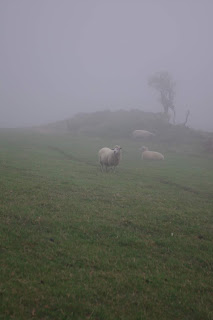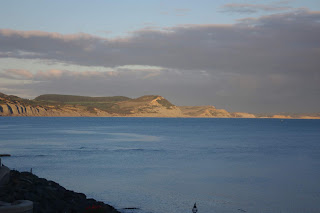A diary of back garden botany, urban ecology, rural rambles and field trips to the middle of nowhere...
Saturday, 15 September 2018
So I hiked a section of the South West Coast Path in Dorset this week starting from Weymouth on Monday, ending up at Lyme Regis on Thursday then heading back to London on Friday.
I picked up the trail where the bungalows and villas of Weymouth meet the Chesil Beach at the southernmost point where the Isle of Portland juts out. Here the Fleet Lagoon stretches westwards for several miles separating the shingle of Chesil Beach from the land.
This vantage point from the campground where I pitched Monday evening shows how Chesil's thin strand forms a barrier between the sea and the Fleet.
On Tuesday's stretch the Coast Path followed the Fleet for a mile or two then angled towards Abbotsbury with its chapel on the hill.
At Abbotsbury I could have continued along the beach but I decided to follow the ridgeway that runs along the low hills above the village. I know this area well and this is one of those locales where the English landscape still has one foot in Avalon. Look on the OS map and it's an epicentre of strip lynchets, tumuli, earthworks, stone circles and other antiquarian remains.
I perambulated out of Abbotsbury up this 'holloway' (see also my entry of March 26th. 2018 concerning Dorset's holloways). The light at the end of the tunnel is something of an illusion however. The hills are low but the cloud was lower, much the same as walking in fog...
This photograph was taken by the earthwork ramparts of an ancient hill fort. A nearby noticeboard says "the sunny limestone bank offers a sweeping view over Abbotsbury and the coast". But not today.
Even though I'm familiar with the Abbotsbury Plains I was pleased when this signpost loomed out of the grey confirming that I was indeed following the South Dorset Ridgeway.
I cut further inland at Knacker's Hole then pitched at a campsite near the lovely village of Puncknowle.
On Wednesday I followed a lane and a footpath through undulating fields back onto the coastal route...
...and tramped along the Chesil Beach- now joined to the land, albeit with some brackish marshes and reedy sumps where they meet.
Walking over shingle is hard going so it was something of a relief where the path ran on solid ground parallel to the beach.
Towards Burton Bradstock and beyond sandstone cliffs rise up and the Coast Path takes the high road...
... with some ups and downs along the way.
Room with a view. On Wednesday evening I pitched at a campsite overlooking Eype Mouth and was treated to a glorious sunset over the ocean and an equally glorious sunrise in the morning.
On Thursday I walked the last leg to Lyme Regis via Charmouth over the knobbly knolls. These steep climbs and plunging paths were some of the most strenuous walking though I'm happy to say my hiking legs were still in good order from the Pacific Crest Trail and Mount Eddy a couple of months back.
When I got to Charmouth the tide was going out, meaning I could walk along the beach itself into Lyme Regis. Above the beach stands the renowned Jurassic cliffs. Here it was that Mary Anning discovered her famous fossils in the nineteenth century.
The cliffs are still slipping and eroding to this day; fossil hunters continue their search for new finds. The walk along the beach was accompanied by the tap, tap, tapping of numerous geological hammers splitting fallen rocks.
The bay between Portland and Lyme Regis is semi-circular. When I got to Lyme I had a view of the entire walk from start to finish. By way of an illustration the above photo shows most of the clifftop section between Burton Bradstock and Charmouth at sundown on Thursday evening.
I pitched at a campsite in Uplyme and took a bus back to Weymouth on Friday. The bus ride along the coast road takes a couple of hours to cover the distance it took four days to walk. Actually it's one of the most scenic bus routes in England but it was satisfying to think I'd done the same miles on foot.
Needless to say one of my motivations was to see what wildflowers I would find and I will make that the subject of my next entry.














